All portfolio items
Colbayns School teachers
| When | Sep 05, 2001 |
|---|---|
| Where | Clacton |
Outline of the presentation:
How do you learn with IT?
- What does it matter?
- jobs, higher education, coping with life - How does anyone believe you?
- examinations, experience, portfolio - communication! - How do you ensure you can convince them?
- prepare well, understand not just parrot - How does learning work anyway?
- expression / evaluation loop
What does this mean for you and IT?
- Use IT to help you 'take risks' with ideas.
- you can always change them easily - Use IT to help you brainstorm.
- you can tidy up later without having to retype
- the screen helps your short term memory - Use IT to create other ways and mixed ways of communicating effectively.
- artwork, diagrams, videos, sounds
- but remember people have to be able to view/hear them - Use IT to help you achieve a high quality of finish.
- but use design as well as fonts - Use all of these to improve what you can do with paper & pencil.
(Words: 205 )
BERA 2001
| When | Sep 14, 2001 |
|---|---|
| Where | Leeds |
This was the programme:
ULTRALAB: a learning technology research centre
Introduction - Prof Stephen Heppell / Richard Millwood
Talking Heads - Leonie Ramondt
NPQH online - Peter Bradshaw
Etui - Richard Millwood
NotSchool.Net - Ian Tindal
Chestnet.net - Ian Tindal
Ultra-language-lab - Alice Mitchell
Learning in the New Millenium - Prof Stephen Heppell
Tesco SchoolNet 2000 - Prof Stephen Heppell
Summary - Prof Stephen Heppell / Richard Millwood
Questions and Discussions - all
(Words: 125 )
Preston Secondary Heads
| When | Sep 20, 2001 |
|---|---|
| Where | Bowness |
The programme:
10.00 - 10.30 Arrival
10.30 - 11.30 Session 1a: What is Learning?
11.30 - 12.30 Session 1b: The Learning Environment
12.30 - 13.00 Check in
13.00 - 14.00 Lunch
14.15 - 15.00 Session 2a: Assessment
15.00 - 15.45 Session 2b: Continuing Professional Development
15.45 - 16.15 Tea
16.15 - 17.30 Session 3: Plenary discussion - implications
19.30 Dinner
and the plan:
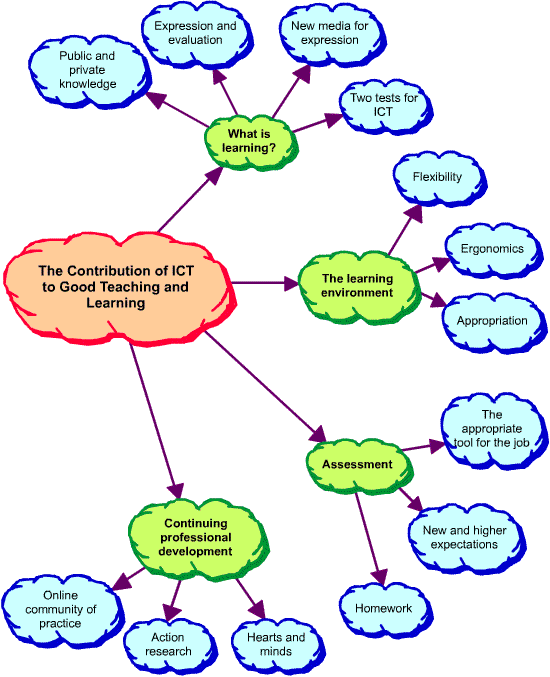
and their views on what they had learnt:
(Words: 130 )
APU Library
| When | Oct 30, 2001 |
|---|---|
| Where | Cambridge |
(Words: 35 )
International Professional Development Association
| When | Nov 03, 2001 |
|---|---|
| Where | Dunchurch |
(Words: 44 )
Kent Libraries
| When | Nov 20, 2001 |
|---|---|
| Where | Maidstone |
(Words: 59 )
South East England Virtual Education Action Zone
| When | Nov 26, 2001 |
|---|---|
| Where | Bromley |
(Words: 38 )
BETT 2002
| When | Jan 14, 2002 |
|---|---|
| Where | London |
The feature was sponsored by EMAP, the BETT show's organiser and Apple Computer. Collaborators included the British Film Institute, Film Education, Youth Culture TV, the South East of England Virtual Education Action Zone, and the Weekend Arts College.
The feature web site summary
- BETT Goes to the Movies was the feature stand at BETT 2002
- It was a partnership between BFI (British Film Institute) Education, Film Education and Ultralab
- It was sponsored and supported by Apple, Emap (BETT organisers) and Oracle
- the event was active from Wednesday 7th to Saturday the 10th of January
- On each day, visiting students engaged in a range of film making activities:
- Wednesday - YCTV (Youth Culture Television)
- Thursday - Film and Video Workshop
- Friday - SEEVEAZ (South East England Virtual Education Action Zone) with Ultralab
- Saturday - WAC (Weekend Arts College)
- Throughout the show, four sixth form students from Colbayns High School in Clacton operated an internet broadcasting station
- They broadcast using ChannelStorm's LiveChannel software facilitated by Ultralab
- Richard Millwood, Matt Eaves, Hamish Scott-Brown from Ultralab supported the stand and fellow Apple Distinguished Educator David Baugh also supported the activities
- Staff from BFI Education and Film Education developed movie editing material based on the film Monsters Inc and on archive footage of the suffragett movement
- The stand also offered a showcase for BFI Education and Film Education materials and products
The feature web site report
Storming ahead in broadcasting? You BETT!
January 14th 2002
Ultralab, Anglia Polytechnic University
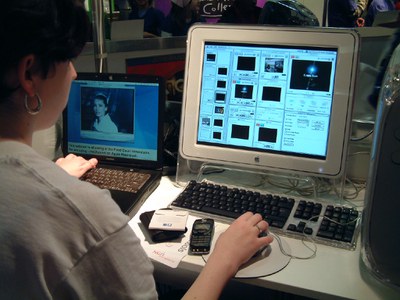
Four students from Colbayns High School, Clacton, Essex pioneered the way in internet broadcasting at the BETT show (British Education and Training Technology) at Olympia, London (Wednesday 9th to Saturday 12th January). Donna Taylor, Donna Cassidy, Lisa McCormack and Becky Hazell broadcast live video footage produced daily by visiting schools and art groups. The BETT event, which has been running since 1984 was attended by 22,000 visitors from all over the world and is attended by key dignitaries within the education field for this country. The eight hour daily broadcast entertained visitors at the first-floor stand and also in the food court downstairs with work created hourly by children filiming and editing at the show and live cameras showing the visiting school and community groups at work. The software used for the broadcasting, 'LiveChannel', is newly developed in Israel by ChannelStorm (http://www.channelstorm.com/)and is tipped to revolutionise and democratise the way students broadcast moving video image. Ultralab (http://www.ultralab.net/), the leading learning technology research centre, based at APU in Chelmsford, responsible for organising the broadcasting event for the show is extremely proud of the achievements of the Colbayns pupils as was Phil Langshaw, Head of Creative Arts & Media at Colbayns school. After a short training session at Ultralab, no more than one hour, the four pupils were technically competent broadcasters and having started, they can confront all the issues facing professional broadcasters - a challenge they savoured. This software has much potential, including the opportunity for schools to quickly and easily set up their own broadcasting TV stations using the Internet to reach a worldwide audience. Richard Millwood, reader and Apple Distinguished Educator at Ultralab said "The main purpose will be to act as focus for tv and radio broadcasting on the net which requires a different, quick thinking, decision making, on-the-fly mentality compared to the more considered composition with iMovie. Also it will provide a series of deadlines for broadcasting events which we intend will stimulate creativity for iMovie compositions, not to say the ability to cut between two live cameras, an audio input and a titling overlay to add life to the whole shebang!"
Richard Millwood and Phil Langshaw intend to develop the use of LiveChannel in a joint project between Ultralab and Colbayns High School to be carried out in the summer term and subsequently throughout the academic year 2002-2003 and are currently looking for sponsors to enhance their proposals.
(Words: 725 )
Fast Track PGCE Brighton
| When | Feb 18, 2002 |
|---|---|
| Where | Brighton |
(Words: 39 )
MSc E-Commerce
| When | Feb 28, 2002 |
|---|---|
| Where | Chelmsford, Essex |
(Words: 32 )
UCISA 2002
| When | Mar 14, 2002 |
|---|---|
| Where | London |
This was the summary slide:
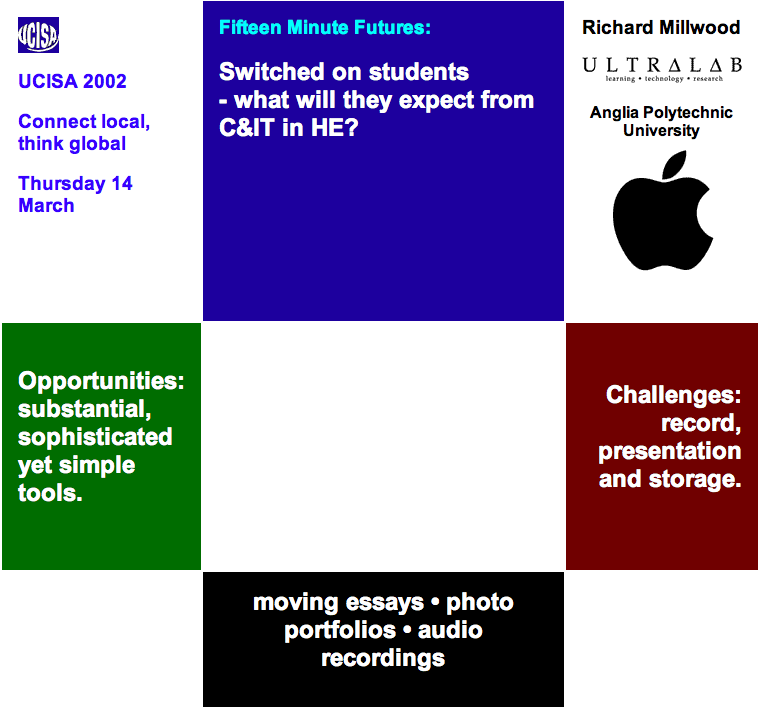
(Words: 50 )
Holy Family Technology College INSET
| When | Mar 22, 2002 |
|---|---|
| Where | Waltham Forest |
(Words: 36 )
Apple Teacher Institute 2002
| When |
Mar 25, 2002
to
Mar 28, 2002 |
|---|---|
| Where | Cheltenham |
(Words: 49 )
MSc in Leadership and Management in Schools
| When | Apr 24, 2002 |
|---|---|
| Where | London |
(Words: 47 )
Newham EAZ
| When | May 02, 2002 |
|---|---|
| Where | London |
(Words: 43 )
Ultralab Open Day
| When | May 14, 2002 |
|---|---|
| Where | Chelmsford, Essex |
(Words: 34 )
Contagious Creativity
| When | Jun 12, 2002 |
|---|---|
| Where | Bristol |
The slideshow we presented, which also framed the workshop:
(Words: 63 )
IFIP TC3/WG3.5
| When | Jul 02, 2002 |
|---|---|
| Where | Manchester |
The summary slide was this:
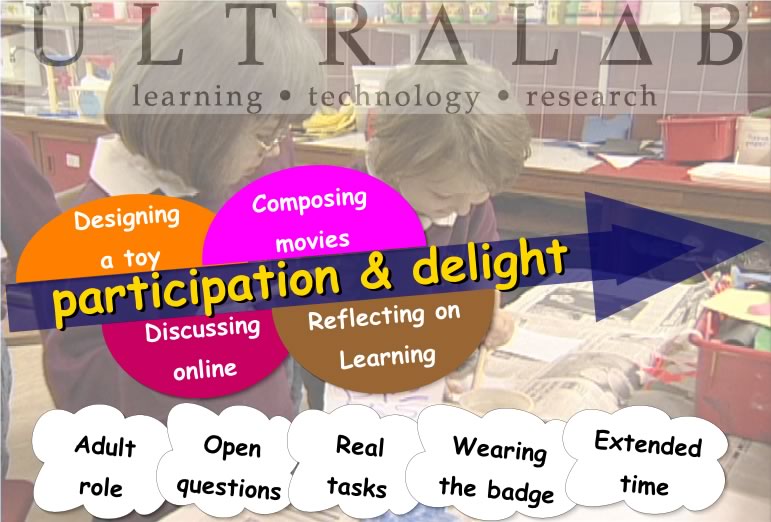
and while I was talking, I handed round a video camera and invited participants to talk to camera with answers to the following questions:
1 What aspect / item / use of technology do you love?
2 What aspect / item / use of technology do you hate?
I compiled the answers into the following movie:
The movie was technically interesting, since it had 3 other tracks as well as the sound. The other three were text tracks - searchable in the QuickTime player of the time.
(Words: 162 )
Yorkshire & Humberside Regional Conference
| When | Jul 11, 2002 |
|---|---|
| Where | Ripon |
(Words: 28 )
ITTE '02 Dublin
| When | Jul 19, 2002 |
|---|---|
| Where | Dublin |
On listening to Eileen Freeman's talk and in subsequent conversations with her, I developed this diagram to try and conceptualise change in the education system:
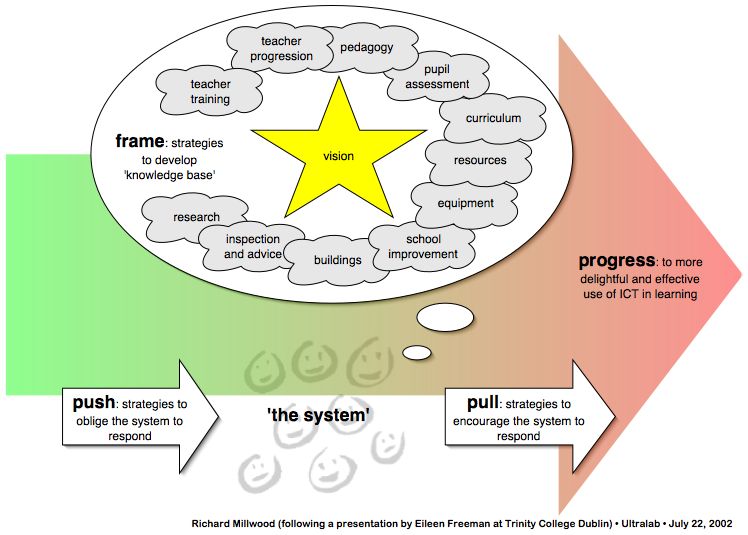
(Words: 72 )
TTA ITT consultation
| When | Jul 22, 2002 |
|---|---|
| Where | London |
The summary slide was:
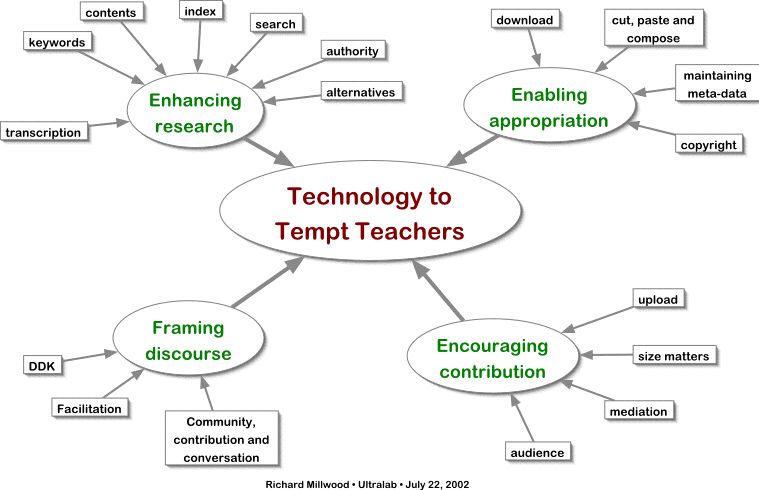
(Words: 80 )
PhD supervisor for Nili Naveh
| When |
Jul 25, 2002
to
Jun 24, 2005 |
|---|---|
| Where | Chelmsford |
Dr Nili Naveh's dissertation can be found in and downloaded from the British Library's EThOS e-theses online service.

Above is the diagram representing her findings/conclusions, the following is her abstract:
Developing of algorithmic thinking in middle school pupils in Israel
"Algorithmic Thinking" is a complex intellectual process of thinking. An algorithm can be defined as a collection of unambiguous executable instructions, whose step by step execution leads to a predefined goal, within a finite number of steps. Algorithmic Thinking in this research means thinking about algorithms, creating, building and solving problems with algorithms.The research presented here, is the first investigation into the development of Algorithmic Thinking processes that take place as Israeli learners in middle school solve problems in computer science.There is little research to be found related to the development of Algorithmic Thinking with middle school learners and findings in Computer Science and Computer Education concerned older students.By contrast, in the field of mathematical education in general, and the psychology mathematical education in particular, there is a wealth of research and accepted theories. Since Algorithmic Thinking is largely of a mathematical nature, studies from the fields of mathematical educationand its psychology were used to review this topic and formulate a theoretical and conceptual framework.One of the main purposes of the research was the construction of a new preliminary theory to describe thinking processes in this field, rather than to prove or refute predefined hypotheses. Consequently, the research was conducted according to a qualitative model, inductively, using the Grounded Theory approach, and it is presented as a case study.The main tool for data collection is the semi structured, ethnographic observational interview. The research took place over two years, and in that time interviews were conducted with 22 pupils from one class in a Tel Aviv Middle School.
The material was analyzed in the light of constructivist approach, which holds that knowledge must be formed in the mind of the learner, due to activities the learner experiences. The constructivist approach provides notions on human thinking, such as the theory of actions-process-object and the fragility of knowledge. These theories are used as explanations for the phenomena found in this study. Another theory used in the data analysis in the research findings, was the Prototype Theory of Eleanor Rosch. The findings of the research were grouped under Cognitive factors and Affective factors. The main finding is students' low level of abstraction of algorithmic concepts, leading to difficulties in solving problems. The findings are summarized into a model of phenomena identified at different levels of abstraction, and the relationship between them.
Using this Grounded Theory approach, the research built new theory which is the contribution to knowledge. This research also makes a practical contribution, as its results have implications for computer science teaching in Israeli Middle Schools. The central recommendation is to prepare a work environment including data structure and actions independent of any programming language, and create suitable activities for the study and development of algorithmic thinking. In this way it may be possible to accelerate the students' advance towards higher levels of abstraction, while minimizing the phenomena that have such a negative effect on their problem solving processes.
(Words: 1124 )
APU Summer School '02
| When |
Jul 29, 2002
to
Aug 02, 2002 |
|---|---|
| Where | Chelmsford, Essex |
(Words: 76 )
PhD supervisor for Lesley McGuire
| When |
Sep 01, 2002
to
Nov 27, 2006 |
|---|---|
| Where | Chelmsford |
(Words: 43 )
[C16] Input CBBC
| When |
Oct 01, 2002
to
Feb 28, 2003 |
|---|---|
| Where | United Kingdom |
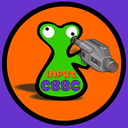
Aim: To design the support web site to explore the potential for students' creativity with video to be broadcast.
Reflection: Although Ultralab had shown that young people were capable of this kind of creativity, we were challenged by working with other adults and young children from a range of backgrounds and the BBC's sense of propriety, health and safety and risk analysis.
Contribution: I took the role of co-leader at Ultralab developing the key values, participant action research approach and philosophy, working with the CBBC Future TV section at the BBC. I took on the visual and information design challenge of presenting help, templates and guidance in a child friendly web-site whilst maintaining a connection to the CBBC's visual style. My part: 25% (with Matthew Eaves and others)
Originality, impact and importance: The project was quite new for a national broadcaster to take a serious view of children's digital creativity. Its impact was on the BBC itself in determining its future policies and confirming the research outcomes from earlier Ultralab projects.
From the final report of the project:
SUMMARY
Input CBBC was a research pilot project which ran from October 2002 to February 2003, developed by CBBC, in collaboration with Ultralab, a research centre of Anglia Polytechnic University. It encouraged a group of children who’d never made a film before to produce their own output. It attempted to give children control at every stage of the process - from idea through editing to screen. It aimed to investigate the best ways to encourage such output, thinking ahead to a future where these methods could potentially be used on projects with bigger scale. Further pilots could also test the viability of children constructing whole magazines for themselves on broadband, with some content produced by them, other content being professional items.
It was known from the start that Input CBBC would be a tall order - the aim was to test its ideas harshly - to see if any child, with no special ability or ambition, could succeed at filmmaking with little guidance.
Forty children in Sheffield and twenty four in Hull, aged ten to fourteen, took part, working in groups of around four. The pilot was conducted “at arm’s length”, through established institutions, such as schools, community groups and City Learning Centres, with each group of children supervised by an approved responsible adult. The adult’s role was to organise film-making sessions, keep children safe, provide limited technological help if the children got stuck - but not to interfere in the creative process.
The children were introduced to digital cameras and to the editing package called iMovie by CBBC and Ultralab, then encouraged to learn through play and experimentation. They were made aware of important aspects about making a film, such as safety, copyright and editorial considerations. Amongst other methods of support available, Ultralab developed a prototype website, which also acted as a base for information and contact.
Final Conclusions
So, to conclude
- this was an experiment - and it was tested really harshly - but still came up with results. It has proved that when children get their hands on equipment they are clearly producing media that is of value to them, for the first time.
- the children and adults were co-researchers, keeping logbooks, doing interviews, being filmed. The research and their films are proving fascinating.
- Input CBBC encouraged some more voices and empowered a group of children to make films
- the other stated aims, of investigating and learning from how best to encourage this material, were met.
- the project established ways of handling health and safety issues and rights management for user-generated CBBC projects at arms length
- Input CBBC helped some children see television with new eyes:
First child: “We know how hard it is to make the films and stuff.”
Second child: “You just watch TV and like you don’t like see all the work that has been put into it.”
First child (of a different group): “I take a bit of sympathy with people who have the worst parts.”
Second child: “Yeh like soaps that have to make four half hour ones every week and it took us three months to do one minute, but they probably have millions of people.”
- Input CBBC has proved children can be creators of content - and these are not children with special abilities or a burning ambition to make films - and they come from many different communities.
- but it is not easy for children to produce films, because of the factors described earlier in this report
- The jury is still out about the true extent that children may in the future be able to contribute en masse to programmes, much as they send letters and pictures in now.
CBBC, as the country’s foremost broadcaster to and for children, remains the best place to give children a voice on television. It is a stated aim that “your input is our output” and this project has fed that aim.
Finally, it is not just broadcasters who have learnt from this experience. Input CBBC has proved that filmmaking is a journey of growing self-discovery, self-expression, self-discovery and confidence building for the children concerned:
“Working as a team gets you a lot further than working by yourself.”
“I’ve learnt how to work as a group. I’ve never done that before. I’ve always wanted to be on my own which is my fault. I’ve learnt to be as a group, to be a good team-member.”
“I’ve learnt not to get frustrated when I want to use the computer and someone else is using it.”
“I can be hard to work with sometimes, very stubborn.”
“I’ve learnt not to get in a moody as such but to join in with the fun.”
“I kinda liked doing everything but I don’t think I would have been able to do it on my own - we needed each other.”
(Words: 1102 )
BCS Schools Expert Panel
| When | Oct 05, 2002 |
|---|---|
| Where | Northampton |
(Words: 27 )
MSc Trinity College Dublin
| When | Oct 25, 2002 |
|---|---|
| Where | Dublin |
(Words: 29 )
[C17] QCA - An Investigation Into Pupils' Creativity Across The Curriculum
| When |
Nov 01, 2002
to
Mar 31, 2003 |
|---|---|
| Where | London |
Aim: To clarify criteria that explain why technology enhances creativity in learning.
Reflection: The summary table at the end of this article was developed by the QCA project to characterise creativity and the rôle of ICT. The development of all of these ideas, in the company of several colleagues who I highly rated for their thinking, gave me confidence in the usefulness of my analysis of the potential contribution of ICT, as my work provided a major part of the 'Features of ICT' column in the table.
Contribution: From my report, the 'Features of ICT' section was adopted by the committee for the final Creativity Framework Taxonomy. My part: 20%
Originality, impact and importance: This was a synthesis of my original thinking and other sources including my experience as a designer in discussion with many others. This was newly articulated in print by me for this consultation and adopted by this national advisory body for advice on future curriculum thinking nationally.
This is the original brief for the work:
Brief
An Investigation Into Pupils' Creativity Across The Curriculum 2000 – 2003
Contractor: Richard Millwood (Ultralab) - Budget Code: Fee: £2000 - Deadline: 24 January 2003
Context
In March 2003 QCA will be providing advice to Creativity Advisory Group (CAG), and then ultimately Ministers, on the potential of ICT for promoting creativity across the National Curriculum. We want your work to inform that advice.
Purpose
To clarify how and why pupils’ creativity is promoted through their use of ICT to develop ideas and judge value and originality.
Requirements
Write a paper which:
- Explains how and why this use of ICT promotes creativity, making reference to:
- the effect of the relevant features of ICT;
- the effect on pupils’ creative thinking and behaviour;
- the types of ICT applications used;
- evidence of the effects of this use of ICT in practice.
- Highlights the potential for this use of ICT to promote pupils’ creativity.
- Makes recommendations and raises key issues.
Critical Success factors
The paper:
- is written in plain English.
- covers the requirements above.
- can be used to inform advice to the CAG and Ministers on how and why ICT promotes creativity.
- is received by the deadline date.
Deadline
Send back the completed paper back to QCA by Monday the 24th of January.
Project Management
Seb Ross, QCA Subject Manager, will oversee the work of the contractor. Please also send the paper via e-mail to rosss@qca.org.uk.
Copyright
QCA owns all relevant data and material produced under this project. A note confirming that the contractor understands these terms and agrees to comply with them will be included in the contract.
My contribution:
An Investigation Into Pupils' Creativity Across The Curriculum 2000 – 2003
Contractor: Richard Millwood (Ultralab)
DRAFT 2 February 14th 2003
Introduction
It is commonly held that the basis for an innovative and financially healthy nation is the creativity of its adult population in the workplace.
"Our success depends upon mobilising even more effectively the imagination, creativity, skills and talents of all our people. And it depends on using that knowledge and understanding to build economic strength and social harmony,"
Charles Clarke, UK Secretary of State for Education
in the government's white paper 'The Future of Higher Education' January 2003
I argue that creativity is more important than that, and that it underpins all learning in the development of ideas and concepts and furthermore fulfilment in people’s lives. As a natural part of everyday activity learners are creative in thought (as they listen, read or watch), natural expression (as they speak, play, perform or make) and more formal recorded expressions (as they write, diagram, prove or program a computer). Information & Communications Technology (ICT) can promote such expressive creativity in a number of ways to be described in this paper.
But expressive creativity has to be matched with evaluative power in order to develop ideas and to judge them for value and originality. ICT also has role to play in enhancing evaluative power. Normally expressive creativity and evaluative power will happen in a cycle of improvement which ICT can enhance and maintain.
To summarise these concepts, the following diagram shows the factors in ICT which might enhance creativity both in expression and evaluation, and which are expanded and developed in this document:
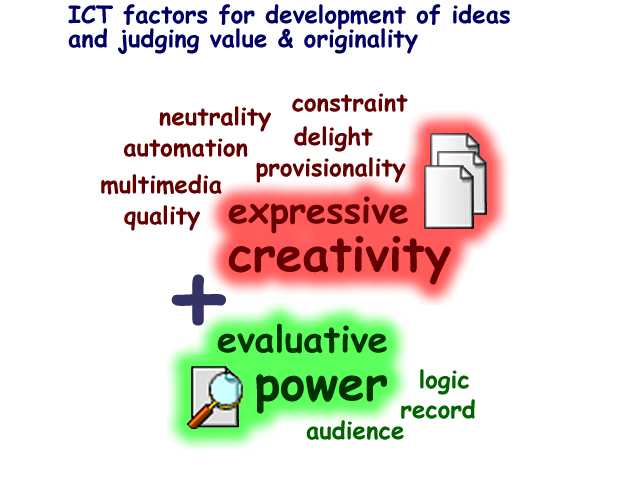
Creativity in the wider context of classroom, school, community, nation or globe demands increasingly higher levels of originality as measured against these wider contexts and the contributions of increasing numbers.
Creativity at each of these levels of society, from individual to global is natural and instinctive, but is inhibited or enhanced by a number of interacting factors, some of which relate to competition and originality (winning or being unique), others to interpersonal and emotional relationships (valuation of oneself in relation to others) and yet more to skills and competence (ability to articulate creativity). Some of these factors are influenced by ICT, some are reduced in their effect as inhibitors and others enhanced by new opportunities.
It’s important to note that ICT cannot act in this way without the complicity of teachers – they are also creative, but need that to be recognised. ICT is often introduced as a support mechanism for the delivery of knowledge, but in this analysis it has to be the tool for developing pupil’s knowledge. Similarly teachers should be encouraged to see this perspective, of a tool culture rather than information culture. Thus teachers will not inhibit such use and indeed can join in the debate about the tool of ICT and how it is best used.
How ICT enhances expressive creativity
Neutrality
In a typical learning environment, students often have a stereotypical interpersonal relationship with those around them including peers and teachers. [Hargreaves 1975] This relationship often includes a judgemental factor, which both the student and the peer or teacher feel and which drives a particular negative behaviour: that of avoiding risks with intellectual ideas. This judgemental factor acts to prevent free expression, either because the student fears approbation or because they wish to please others, particularly the teacher, by seeking their answer already known to them but unknown to the student. This in turn inhibits development of new ideas – good teachers (and friends) know how to turn this judgemental factor off explicitly when appropriate.
With ICT equipment, as with other tools and vehicles, there is an imaginary interpersonal relationship (consider the way in which ships are often called ‘she’ and imagined to have a life of their own). After some acquaintance with computers over a period of time, young people see through any pretence of intelligence or life in a computer and thus begin to see it as a neutral tool which although it may offer canned feedback, is clearly incapable of judgement. Computers allow students to ‘say things out loud’, but without judging those things in an interpersonal manner. The computer is a silent helper in this sense and can be trusted with half-formed ideas and ideas which follow the students creative impulse.
Automation
A powerful spur to more complex expressions of ideas is the ability to re-express cheaply and repetitively. The potato print transforms a simple shape into a rich pattern, the ‘automation’ provided by this simple tool allows a variety of re-arrangements of the shape to be explored at low cost and with reliable quality.
Computers provide this kind of automation and much more, through copy and paste in almost every program, through formulae and ‘Fill down’ in a spreadsheet and, most important of all, through programming languages.
Arguably, programming has lead to the current information age, since all technologies related to ICT rely on computer programs to automate functions to a level where qualitative changes in education, the workplace and society as a whole have taken place and are still developing. This explosion in creativity ought to be more widely available to all learners in educational contexts, but suffers from a disregard for tools which is an endemic problem in our society [Owers 2001].
Multimedia
The capacity for learners to use multiple media through ICT increases the opportunity to work in alternate modalities to the predominant reading and writing. ICT simplifies the production of visual and aural media as well as making viewing and listening a more delightful engagement with material. Of even greater consequence is the potential for reconstruction in film, hypermedia (the establishment of networks of knowledge) and linear presentations. These are integrations of multiple media and are perhaps the most demanding of communications, not only anticipating audience viewing but also audience choice of sequence.
Quality
ICT media are unique in that little imprint of the creator’s weakness in production are seen – perfect fonts, geometric accuracy and colour faithfulness permit the weakest of learners to produce material which compares, on the level of media quality, with that of the most experienced professional. This means that learners’ self-esteem, which is so heavily knocked by poor handwriting, inaccurate drawing or inadequate oral skills, can be raised. This in turn encourages risk-taking and attention to the content of ideas – continuing engagement which can lead to judgements about higher-order issues on a level playing field.
Constraint
ICT tools can promote the development of ideas, paradoxically, by constraining the universe of possible expressions. In many of the arts, the choice of constraint can lead to greater fertility by focussing on specific aspects of ideas – this kind of limit can offer similar gains in ICT. In graphic programs, limits on the position of the cursor to a grid can lead to the rapid development of diagrams. In geometry programs in Maths, constraints can help learners see important connections and propose new interpretations of figures.
Delight
The computer frequently pleases, aesthetically and affectively, in a way that delights the learner. This positive mood is clearly valuable to creativity, as a means of sustaining motivation at the very least.
Provisionality
In order to embark on any piece of work of substance, a start has to be made – for many learners, making this start is difficult because making mistakes has such a disastrous effect on continuation. Many young people in schools use correction fluid to eradicate ‘errors’ as they perceive them, or resort to ripping pages out of books in order to achieve a ‘perfect’ copy. Provisionality is that certain knowledge that with a computer, one can begin developing ideas and, at little labour cost, perfect and re-draft those ideas with no evidence of the process. This means that for creativity, one can start recording ideas out of order, in draft form and incomplete. For many, this knowledge unlocks their ideas, which would otherwise not be worth expressing.
How ICT enhances evaluative power
Logic
Computers offer a powerful tool for certain ideas, which are developed in symbolic, formal languages. These include spreadsheet formulae, programming languages and database design. If these formal systems are used to develop ideas, then it is possible for the computer to ‘execute’ them and display their consequences. Often, in order to judge the success of an idea, this output can be compared to that anticipated and evaluation independent of a peer or teacher can take place. The programming language Logo has provided a powerful example of this effect, in some cases leading learners into extraordinary intellectual and creative endeavour. [Papert 1980]
Record
Most work on a computer can be saved for later perusal or saved at intervals to record drafts. In the development of ideas this can help learners see how their ideas have developed, or peers and teachers to understand and judge their value and originality. In the long term, work that has been saved in this way and compiled provides a portfolio of work. This portfolio can be used to represent the learner’s capability, but also may be mined for new starting points by that learner in a much more accessible and labour saving way than with a traditional portfolio. New connections can be made between past work and present concerns – often surprising insights can be obtained, because ICT has recorded the work and allowed searching and indexing to take place.
Audience
ICT offers a number of ways to allow communication of ideas to take place, both deliberately and serendipitously. By using presentation tools, learners can show and defend their ideas to audiences in the whole classroom, potentially with access to to the whole body of their work (see Record above).
This kind of ICT use, using projectors or large screens in a classroom context, enhances another kind of creativity which may be teacher-led. This is described as ‘interthinking’ [Mercer 2002], where learners sharing a knowledge context and background, debate together, seeking each other’s views and respecting diversity but also working towards consensus. The projected computer screen is a focus for representing the current state of the ideas being developed by the class. Some software has been specifically designed to benefit from this shared working knowledge [Millwood & Mladenova 1994], but all software can be used in this mode. It has many of the advantages described above for the individual, but now for the group e.g. quality, multimedia and provisionality. Each of these promote creativity to a far greater degree than a more traditional whiteboard.
By joining online communities through the Internet, a wider, but identified audience can be found for ideas and dialogue with others following the same interest can be informative in order to judge work. Publishing material on web pages permits the globe to take part in the evaluation of ideas and work. This is clearly potential audience not real audience, not all viewers will see or comment on such work. Nevertheless the power of potential audience to support both expression and evaluation is very real in the mind of the learner and can provide powerful motivational force and raise ambition.
Conclusion
The analysis of the development of ideas as a cycle of expressive creativity and evaluative power helps us identify key factors which ICT offers to promote such development, but also the judgement of both value and originality.
References
- Hargreaves, D.H., (1975), Interpersonal Relations and Education, Routledge & Kegan Paul.
- Owers, S.C. (2001), The Place And Perception Of Technology In The Curriculum, PhD thesis available at http://www.ultralab.net/tools/
- Papert, S. (1981) Mindstorms, Harvester Press.
- Mercer, N. (2002)
- Millwood R., Mladenova G., Modelling with ordinal data to support debate of subjective issues, proceedings of East-West conference Computer Technologies in Education part 2 p166, Crimea, Ukraine, 1994
QCA's Creativity Framework Taxonomy
|
Definition of Creativity |
Pupils Creative thinking and Behaviour |
Use of ICT |
Features of ICT |
ICT Applications |
|
|
|
|
|
|
NACCCE: All our futures: Creativity, Culture and Education, 1999. |
Taken from Creativity Pack information sheet 3 (September 2002)
|
Developed from: Draft Literature Review in New Technologies and Learning – A report for Nesta FutureLab (A.M. Loveless October 2002) |
Developed from ICT features defined by DFEE 1998 and R Millwood (Ultralab) presentation (October 2002) |
Taken from: Key Stage 3 National Strategy – Framework for teaching ICT capability: Years 7, 8, 9 (DFES 2002) |
(Words: 2870 )
Hertfordshire ICT
| When | Nov 01, 2002 |
|---|---|
| Where | Wheathampstead |
(Words: 23 )
Beyond the Backlash
| When | Nov 07, 2002 |
|---|---|
| Where | London |
(Words: 50 )

